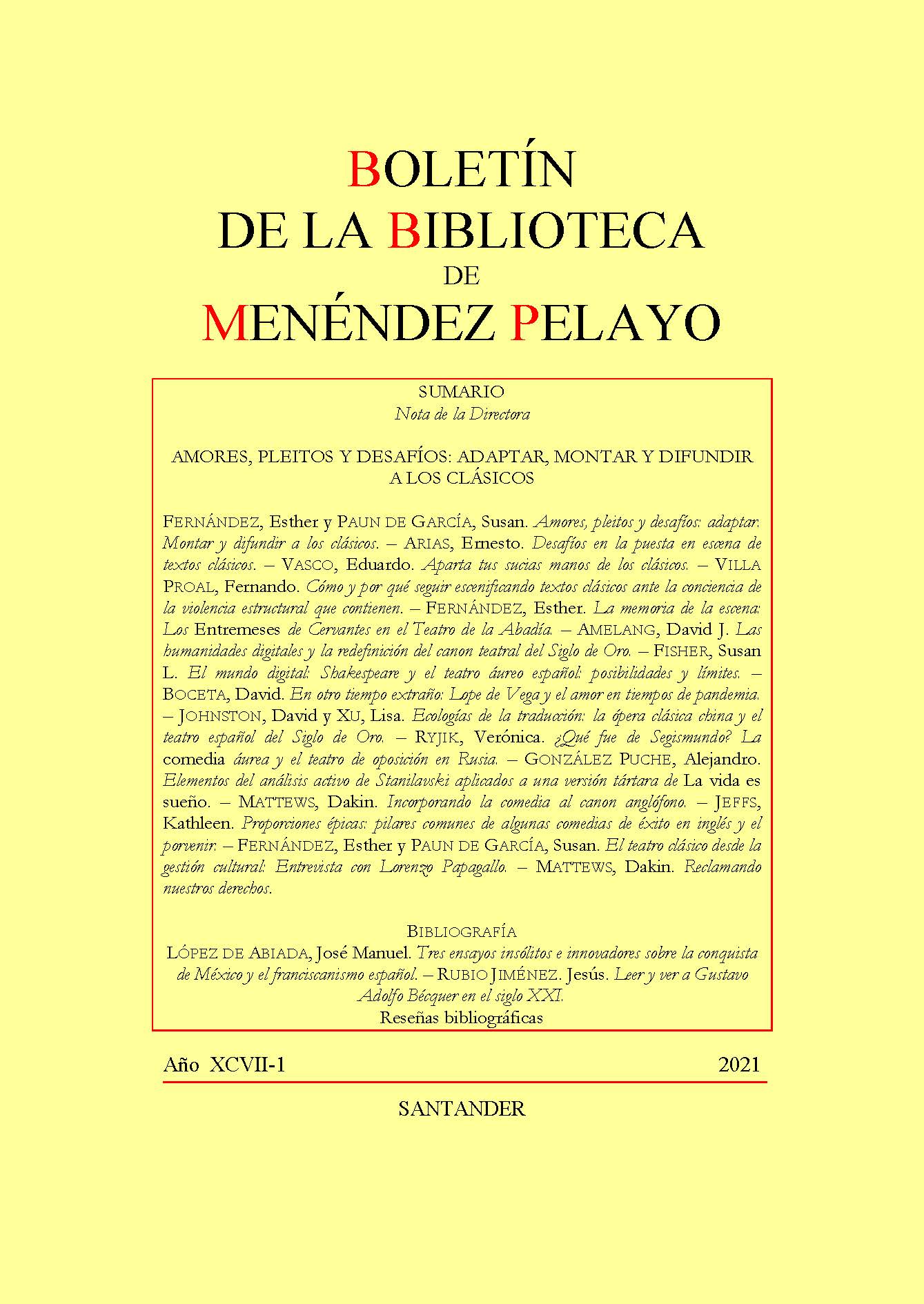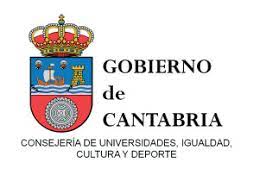Epic proportions: common pillars of some successful comedies in English, and the future
DOI:
https://doi.org/10.55422/bbmp.277Keywords:
Comedia, Translation, Peformance, Design, EndingsAbstract
The surge in performances of Spanish Golden Age plays catalyzed by the Royal Shakespeare Company’s Spanish Golden Age Season in 2004-05, and the many subsequent productions including those at the Bath Theatre Royal, offered translators, directors, and producers an opportunity to build on those foundations and expand into new territory. In this study, Jeffs explores the essential elements of the comedia performance canon in English, offering foundational principles of successful productions in which she has participated or observed. These elements include the ineffable but critical pillar of tone and the freeing limits of genre; the importance of design; the danger and beauty of contrasts and juxtapositions; and the power of open endings. This study picks out the moments in relatively recent comedia production processes and suggests fresh texts for performance that utilize the best building material for a sustainable future of the comedia in diverse forms.
Downloads
Publication Facts
Reviewer profiles N/A
Author statements
Indexed in
- Academic society
- Sociedad Menéndez Pelayo
- Publisher
- Sociedad Menéndez Pelayo
Global Statistics ℹ️
|
119
Views
|
143
Downloads
|
|
262
Total
|
|
References
BENTLEY, Eric. (1985). Notas a Life Is a Dream and other Spanish Classics. Ed. Eric Bentley. New York. Applause. 293-297.
BOURDIEU, Pierre. (1990). The Logic of Practice, Trad. Richard Nice. Palo Alto. Stanford University Press.
CALDERÓN DE LA BARCA, Pedro. (2003). Devotion to the Cross. Trad. Edwin Honig. En Calderón de la Barca: Six Plays. New York, Institute for
Advanced Studies in the Theatre Arts. 69-132.
CALDERÓN DE LA BARCA, Pedro. (1995). The Painter of Dishonour. Nueva version de David Johnston y Laurence Boswell. Bath, England. Absolute Classics.
CAMPBELL, Joseph. (1968). The Hero with a Thousand Faces, 2ndedición. Princeton, New Jersey. Princeton University Press, Bollingen Foundation.
CASTRO, Guillén de. (2019). La fuerza de la costumbre (The Force of Habit)/ Trad. Kathleen Jeffs. Edicion con introducción crítica de Melissa Machit. Liverpool University Press.
CERVANTES, Miguel de. (1985). The Siege of Numancia, trad. Roy Campbell. En Life Is a Dream and other Spanish Classics, ed. Eric Bentley. New York. Applause. 1-64.
CONNOR (SWIETLICKI), Catherine. (2000). «Marriage and Subversion in Comedia Endings: Problems in Art and Society». En Gender, Identity, and Representation in Spain’s Golden Age, eds. Anita K. Stoll y Dawn L. Smith. Lewisburg: Bucknell University Press. 23-46.
DIXON, Victor. (1981). Introducción. El perro del hortelano. By Lope de Vega. London. Tamesis. 9-67.
FISCHER, Susan L. (2009). «Calderón and the contingency of radical tragedy: The Painter of Dishonour (El pintor de su deshonra)». En Reading Performance: Spanish Golden Age Theatre and Shakespeare on the Modern Stage. Woodbridge. Tamesis. 179-202.
GODDARD, Julie. (2004). «Pride and the Passion of 17th-century Spain: The Gentleman from Olmedo, at The Watermill Theatre, until May 22.» Newbury Weekly News. https://www.newburytheatre.co.uk/archive/200404e.htm.
HALL, Peter. (1999). The Necessary Theatre. New York. New York. Theatre Communications Group.
JEFFS, Kathleen. (2018). Staging the Spanish Golden Age: Translation and Performance. Oxford. Oxford University Press. DOI: https://doi.org/10.1093/oso/9780198819349.001.0001
-----. (2019). «In Review: The Mountain Girl from La Vera». The Mercurian. 7. 4. 160-164.
JOHNSTON, David. (1995). Nota del traductor. The Painter of Dishonour. De Pedro Calderon de la Barca. Bath, England. Absolute Classics. 8-10.
LINDSAY, Katrina. Entrevistada por Kathleen Jeffs. (8 July 2004). The Other Place, Stratford-upon-Avon, the Ashcroft Room.
MCKENDRICK, Melveena. (1996). «‘Retratos, vidrios y espejos’: Images of Honour, Desire and the Captive Self in the Comedia». Revista Canadiense de Estudios Hispánicos. 20. 267-283.
ORMEROD, Ben. Entrevisstado por Kathleen Jeffs. (April 20, 2004). The Thistle Hotel, Stratford-Upon-Avon.
SHAKESPEARE, William. (2007). Hamlet. En William Shakespeare’s Complete Works. Ed. Jonathan Bate y Eric Rasmussen. Royal Shakespeare Company, Modern Library, Random House.
SMITH, Rae. Entrevistada por Kathleen Jeffs. (31 August 2004). Swan Theatre, Stratford-upon-Avon.
THACKER, Jonathan. (2018). Estudio introductorio de La creación del mundo de Luis Vélez de Guevara, Ed. William R. Manson y C. George Peale. Ediciones críticas 94. Newark, Delaware. Juan de la Cuesta. 13-39.
VEGA, Lope de. (1992). The Gentleman from Olmedo. Trad. y adapt. David Johnston. En Lope de Vega: Two Plays, pp. 87-159. Bristol. Absolute Classics. El texto citado en este capítulo es de la versión de David Johnston producida en el Watermill en 2004 (texto de performance por cortesía de David Johnston).
VEGA, Lope de. (1995). El caballero de Olmedo, ed. Vern Williamsen. http://www.comedias.org/lope/cabolm.html.
VEGA, Lope de. (1981). El perro del hortelano. Ed. Victor Dixon. London. Tamesis.
VÉLEZ DE GUEVARA, Luis. (2018). La creación del mundo. Ed. William R. Manson y C. George Peale. Ediciones críticas 94. Newark, Delaware. Juan de la Cuesta.
-----. (2019). La Serrana de la Vera (The Mountain Girl from La Vera). Traducido con introducción critica de Harley Erdman. Liverpool University Press.
VIDLER, L. (2012). «Bourdieu, Boswell and the Baroque Body: Cultural Choreography in Fuenteovejuna». Comedia Performance. 9. 1. 38-64. https://www.academia.edu/1416507/Bourdieu_Boswell_and_the_Baroque_Body_Cultural_Choreography_in_Fuenteovejuna. DOI: https://doi.org/10.5325/comeperf.9.1.0038
Downloads
Published
How to Cite
Issue
Section
License
Copyright (c) 2022 Kathleen Jeffs

This work is licensed under a Creative Commons Attribution-NonCommercial 4.0 International License.







